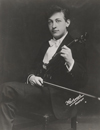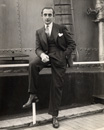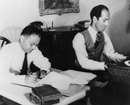All material found in the Press Releases section is provided by parties entirely independent of Musical America, which is not responsible for content.
Press Releases
April 9: Sony Classical releases Eugene Ormandy and The Philadelphia Orchestra - The Columbia Legacy on 120 CD Box Set
FOR IMMEDIATE RELEASE
Media Contacts: Maggie Stapleton, Jensen Artists
646.536.7864 x2 | maggie@jensenartists.com
Sony Music Masterworks: Larissa Slezak / Jamie Bertel
212-833-6075 / 8575 / 7549
Eugene Ormandy | The Philadelphia Orchestra
The Columbia Legacy - The Legendary Mono Recordings 1944–1958
120 CD Box Set Available April 9, 2021

152 recordings on CD for the first time ever
139 recordings for the first time on CD as authorized releases from the original masters
16 remastered recordings, all in their original LP artworks
Granting a long-held wish of many record collectors, Sony Classical is issuing the complete monaural American Columbia discography of Eugene Ormandy and The Philadelphia Orchestra in a vast box set of 120 CDs, all in new remasterings, available April 9, 2021. Almost all of this material will be appearing for the first time on CD on Sony Classical. Furthermore, 152 of these recordings have never been released on CD before now.
Named co-conductor of The Philadelphia Orchestra alongside Leopold Stokowski in 1936, Ormandy became music director two years later and held the position for 42 years. During that time – in which his name and the Orchestra’s became inseparable – he cultivated and further developed the voluptuous sound that originated with his predecessor. “Any conductor reflects clearly the instrument he played,” the Budapest-born Ormandy (1899–1985) once said. “My sound is what it is because I was a violinist.” The American composer and critic Virgil Thomson described Ormandy’s “Philadelphia Sound” as “pungent and mellow like the smell of fall fruits. No other instrumental assembly has quite the quality of impersonal, almost botanical, beauty that this one possesses; and none of the other conductors who appear regularly before us has quite Eugene Ormandy's way of offering really excellent workmanship without personal insistence.”
“From Leopold Stokowski to Yannick Nézet-Séguin, each Philadelphia Orchestra music director brings a unique artistic vision,” said Philadelphia Orchestra President and CEO Matías Tarnopolsky. “The legacy of Eugene Ormandy, preserved so masterfully in this 120-disc collection, is one that has become synonymous with the Philadelphia Sound. It is our wish that new and longtime listeners alike rediscover these beloved recordings that trace our storied history.”
Ormandy and his Philadelphians were among the most prolific recording artists of all time. Between 1944 and 1968 (preceded and followed by contracts with RCA Victor), they were associated exclusively with American Columbia. Ormandy was a committed recording enthusiast, working quickly and readily accommodating the company’s planning in order to produce best-sellers. His frequent tours with the Orchestra were aimed not just at added exposure but also at boosting record sales. The Philadelphia Orchestra’s tour to Great Britain in 1949 marked the first time an American orchestra had performed overseas since 1930.
Ormandy was responsible for numerous premieres in Philadelphia, championed the music of Bartók (a personal friend), and was the favored interpreter of Rachmaninoff. His 1952 Philadelphia recording of Honegger’s oratorio Jeanne d’Arc au
One of Ormandy’s earliest Columbia recordings, dating from 1944 and never before transferred to CD, is a wartime rarity, the patriotic four-movement Symphonic Suite My Country at War by the Leipzig-trained Harl McDonald (1899–1955), who was also The Philadelphia Orchestra’s manager. The Latvian-born composer Louis Gesensway was a violinist in the Orchestra. His “symphonic poem for large orchestra, narrator and street-criers” Four Squares of Philadelphia (1948–51) evokes the four famous expanses of grass and trees laid out in 1681 by William Penn, founder of the “City of Brotherly Love”. Other recordings of American repertoire in the new set making their CD debut include William Schuman’s Third Symphony and four works by the Philadelphia-based composer Richard Yardumian: his Armenian Suite, Desolate City, the Second Symphony “Psalms” for contralto and orchestra, and the Violin Concerto (with soloist Anshel Brusilow).
Sony Classical’s new Ormandy/Philadelphia box is filled with familiar and unfamiliar works by virtually every major composer from Bach to Beethoven to Brahms to Berg to Bartók to Bernstein and beyond. It would be impossible to list them all, but just citing some of those recordings that have never before been released on CD gives a good idea of the breadth of repertoire contained here. Symphonies include the Franck D minor and Beethoven’s Ninth (both recorded in 1945), Brahms’s Third (1946), Tchaikovsky’s Fourth (1947), Haydn 101 “Clock” (1949), Haydn 100 “Military” (1953), Brahms’s First and the Berlioz Fantastique (both from 1950), and Beethoven’s Fifth (1955).
Recordings of suites new to CD include Handel’s Water Music (in Ormandy’s own arrangement) and Kodaly’s Háry János (both from 1946), Ravel’s two suites from Daphnis et Chloé (with the Temple University Choir; 1949/50), Chopin Les Sylphides (1954), Grieg’s Peer Gynt and Bizet’s L’Arlésienne (both from 1955), and Khachaturian’s Gayane and Kabalevsky’s Comedians (both from 1956). Other CD premieres include Debussy’s “Nuages” and “Fêtes” from “Nocturnes” (recorded in 1944), Respighi’s Pines of Rome and Roman Festivals (1946) and Ravel’s Rapsodie espagnole (
Ormandy’s Austro-Hungarian roots and experience as a conductor of light music made him a natural interpreter of Viennese waltzes and polkas. He and his Philadelphia musicians recorded music by the Strauss family almost every year between 1951 and 1958 (“It is a real joy to hear such facility and drive coupled with lightness and clarity” – High Fidelity). Sony is also including Ormandy’s complete 1950 recording of Die Fledermaus from the Metropolitan Opera, sung in English, with Ljuba Welitsch as
Many classic concerto recordings came out of Philadelphia in the 1940s and ’50s. They are all to be found in the new set, beginning in 1944/45 with Lalo’s Symphonie espagnole (“Ormandy knows the terrain perfectly, bringing the winds forward when required and drawing out the lower strings powerfully: it helps to have so superbly virtuoso an instrument at The Philadelphia Orchestra playing, of course. [Nathan] Milstein remains...the embodiment of perfect violin playing” – MusicWeb International). Pianist Rudolf Serkin was in his prime and one of Columbia’s foremost artists in this period. He can be heard in the Schumann Concerto from 1946 (“Probably the best all-around version available” – Gramophone’s original review from 1948), the five by Beethoven (1950–55), Brahms No. 2 (1945 and again in 1956) and the Strauss Burleske (1955 – “The pianist’s stunning mono version...a riproaring
In his obituary of the conductor in 1985, the American critic Thor Eckert Jr. wrote that “the Ormandy style came to its apex in the Russian repertoire. His interpretations of Rachmaninoff, Prokofiev, Tchaikovsky, Rimsky-Korsakov, and Shostakovich were incomparable”. Sony Classical’s new edition includes Ormandy’s recordings of all these composers, none more famous than his readings of works by his close friend Sergei Rachmaninoff: the Second (recorded in 1951) and Third (1954) Symphonies, The Bells and Isle of the Dead (1954), and the Second Piano Concerto (with Eugene Istomin; 1956). Ormandy’s mono version of Tchaikovsky’s “Pathétique” was lauded by High Fidelity when it was released in 1952: “On the evidence of this staggering recording, something like the ultimate has been reached in capturing the splendor of this orchestra's unparalleled sound. The quality and depth of individual instrumental sound, properly placed and justly balanced, has not been committed to records before with greater fidelity. Particularly this applies to the opulent string tone. Steering a course between over emotionalism and severe detachment, Ormandy's reading is lucid, broad and convincing.”
In a recent Gramophone Ormandy
To cover The Philadelphia Orchestra’s history of mono recordings on Columbia Masterworks, it was decided to also include recordings conducted by Alexander Hilsberg, Eugene Ormandy’s associate conductor (1945–1952), as well as recordings by the guest conductors Sir Thomas Beecham, Saul Caston, Charles O’Connell, Harl McDonald, André Kostelanetz, Virgil Thomson and Bruno Walter. The listener can also enjoy recordings by the Philadelphia “Pops” Orchestra, as well as some made by the so-called Columbia Symphony Orchestra in sessions in which its players consisted mainly of “Philadelphians”. In a few instances repertoire recorded by other conductors such as Dimitri Mitropoulos, Serge Koussevitzky, George Szell or Fritz Reiner with “their” orchestras is also included in the boxset, when it was felt that the listener might enjoy hearing the complete repertoire of an original LP release.
Set contents: For full repertoire, please see accompanying Promo Booklet PDF here
Specifications:
International release date: April 9, 2021
Physical Product: 19439757482
Barcode: 194397574821
Configuration: 120 CD box set with hard cover bound book in rigid box (Lift-off lid box)
Size: L 279 cm x W 214 cm x H 160 cm
Weight: approx. 5.8 kg
Audio playing time: approx. 100 hours
___________________
Robert Russ, music producer from Berlin-Reinickendorf, Germany. He is the first German producer to be awarded with a Grammy® for the Best Historical Album at the 60th Annual Grammy® Awards in 2018. Since 2017 Russ received five Grammy® nominations in four consecutive years in the historical category.
Martin Kistner and Matthias Erb, mastering engineers from Berlin, Germany, both work for b-sharp studios. Kistner joined b-sharp in 2008. After completing his studies in sound engineering at the Berlin University of the Arts in 2010, he took on his own recording projects in Germany and abroad. He is the mastermind at b-sharp in the area of remastering. Erb completed his sound engineering diploma at the Berlin University of the Arts in 2012. Before entering the b-sharp team in 2017, he worked as a freelancer for various cultural institutions and ensembles. Erb also teaches as a guest lecturer in the “Digital Media Arts” course at the Shanghai Conservatory of Music. Both Kistner and Erb earned their first Grammy® nominations for Best Historical Album in 2017, the year in which Kistner won his first Grammy® as mastering engineer.
Andreas K. Meyer, transfer, restoration, and mastering engineer, has worked as a producer/engineer with artists such as Hilary Hahn, Joshua Bell, Yo-Yo Ma, Esa-Pekka Salonen, Arcadi
Jennifer Nulsen, transfer, restoration, and mastering engineer, is a Grammy®-nominated member of the Swan Studios NYC team, where she has worked on multiple releases for Sony Masterworks, Sony Classical, Deutsche Grammophon, Mosaic, Delos, and others. She holds a master’s degree in sound recording from McGill University, where she received the prestigious Bruce Swedien honorarium from the Audio Engineering Society. She also works regularly with the New Jersey Symphony, Boston Symphony, Cleveland Symphony, and Boston Pops orchestras as a freelance engineer.
# # #





 FEATURED JOBS
FEATURED JOBS

 RENT A PHOTO
RENT A PHOTO


